|

A Classy Show
Pimlico Opera's 'Rigoletto',
reviewed by ROBERT HUGILL
Operating on a tight budget, it must be difficult for opera companies to come up with economic ideas for staging Rigoletto; Renaissance settings don't come cheap, and young singers usually require a decent rehearsal period if their body language and mannerisms are to be believable in the period setting. Few small companies can afford the lavishness of David McVicar's modernist take on the Renaissance at Covent Garden. But to attempt to transpose the work to the twentieth century risks setting oneself up against Jonathan Miller's deservedly iconic New York Mafia staging at the London Coliseum.
For many period operas, small companies opt for the simplified period style, both Grange Park Opera and English Touring Opera have done this in operas like Donizetti's Maria Stuarda. But in Rigoletto directors want to make the plot more meaningful to contemporary audiences. Miller's ENO staging transposed the action to twentieth century New York not because it was pretty, but partly because it wasn't. It worked because the plot fitted the new milieu and made the violence more immediate than a Renaissance setting, which usually prettifies the plot, hiding the real violence at the heart of this troubled opera. All of the male characters in Rigoletto are violent and the main character is profoundly conflicted, hell bent on revenge against a duke who should embody moral order but does not.
The twin weaknesses of Miller's Mafia staging were the uncertainness of Rigoletto's role as jester in the new setting and the fact that we are unsurprised if a Mafia capo is not a paragon of moral order. But this was hidden by the way the staging seemed so dazzlingly right in many ways.
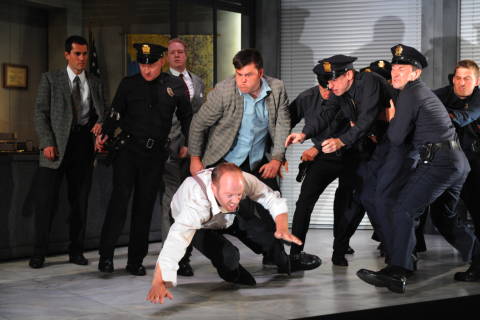
Adam Green as Rigoletto, centre, with Fran Garcia as Marullo, Paul Sheehan as Ceptrano and chorus in Act II of Grange Park Opera's 'Rigoletto' at Nevill Holt. Photo © 2009 Alastair Muir
|
For Grange Park Opera director Daniel Slater and designer Angela Davies attempted to redefine the piece by setting it in and around a Los Angeles police precinct in the 1940s, with the Duke as a glamorously corrupt police chief. The production was new at Grange Park Opera's Nevill Holt out-station this summer, cast with young singers from Grange Park Opera's Rising Stars. The same cast performed it at Pimlico Opera (seen Saturday 3 October 2009, revival director Peter Relton) on what was planned as the start of their annual autumn tour. Unfortunately the Arts Council withdrew funding this year so that the tour was reduced to two dates at Grange Park Opera in Hampshire and one at London's Cadogan Hall.
I can understand conceptually why Slater and Davies moved the opera to a Los Angeles Police precinct, evoking perhaps memories of LA Confidential. Intellectually, the setting provided many of the requirements needed and helped explain why there was only a chorus of men, but the staging did not convince me emotionally. Things got off to an awkward start as the opening party scene was transformed into a party cum press conference. The cast enthusiastically followed Slater's detailed scenario, but it was just acting and neither they nor we were convinced. An added problem in this scene is that Verdi's music sounds too disjoint from a twentieth century milieu: it fits far better with the period original.
James Edwards unfortunately looked neither glamorous nor dangerous enough as the Duke. He sang with a glorious Italianate tone, but his character failed to reflect this. His voice had an element of would he/won't he when it came to his top notes, which made me wonder whether he had a cold, though this was not mentioned. His voice seemed to gradually warm up (neither the weather nor the theatre were very warm) and became beautifully secure by the last act.
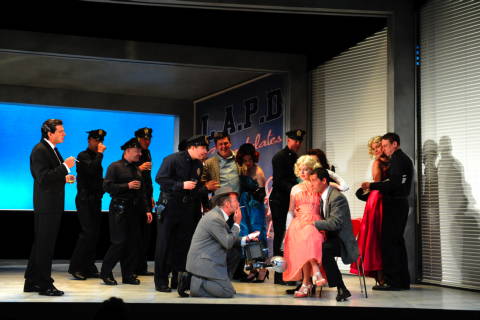
Fran Garcia as Marullo, seated, and chorus in Act I of Grange Park Opera's 'Rigoletto' at Nevill Holt. Photo © 2009 Alastair Muir
|
As Rigoletto, Adam Green had an attractive light baritone voice with a vibrato which was substantial enough to be worrying in one so young. Carrying a cane with a built up shoe, his role in the revised scenario was vague. Perhaps he was the wise cracking veteran detective, but even then such detectives would work in pairs. Green managed well enough musically but his soft edged tone failed to bring the element of anger and sarcasm needed in his jesting in the first scene. Green seemed simply too nice a guy and could couldn't understand why the policemen/courtiers would not have liked him.
The strongest, most dangerous performance in the first scene came from Peter Willcock as Monterone, who demonstrated just what should and could be done; his curse had a real element of danger and of venom, though I was completely befuddled as to why he should be dressed as an orthodox Jew.
In the second part of Act I, Ronald Nairne brought a nice element of menace to his portrayal of Sparafucile. In this scene Green was on surer form, a conflicted but good man at sea in a puzzling world. Laura Mitchell as his daughter Gilda was very much the real thing. Her spinto soprano supplied a wonderful sense of line and she provided the strongest dramatic performance of the evening, entirely convincing as a young girl. Her voice had all the notes for Cara nome but they were a little too steely, though she gave such a totally consummate stage performance that you entirely forgot this. Green and Mitchell were very touching in their duet in this act. Unfortunately Edwards remained a little lumpen dramatically to convince as the Duke. His lyrical vocal ardour only occasionally reached his body language.
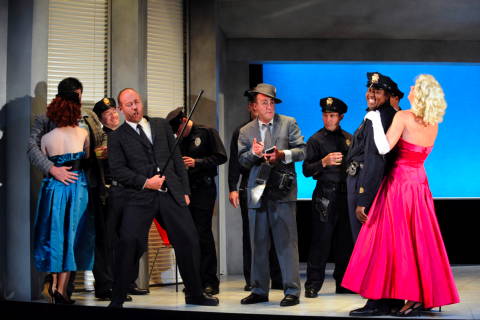
Adam Green as Rigoletto and chorus in Act I. Photo © 2009 Alastair Muir
|
In Act II, I was unsure whether Edwards' tendency to stand and deliver was a habit that the director hadn't broken him of, or an attempt to make the Duke butch and dangerous; if the latter then I'm afraid the attempt failed, as Edwards' Duke rarely seemed dangerous enough.
It was in Act II that the problem of casting a young baritone in the title role became most apparent. Green's account of Cortigiani simply lacked the heft necessary; baritone voices are notoriously slow to develop. Instead he tended to break up the line so he could attack individual notes, with a fatal effect on the structure of the piece. But all was transformed when Mitchell's Gilda appeared. She was simply stunning as the traumatised girl, her acting knocked everything else off stage. She lifted Green with her so that their final duet was profoundly moving, Green's attractive soft grained voice being more suited to the role at this point as well.
Act III continued at this promising level. Nairne and Karina Lucas as Sparafucile and Maddalena fully inhabited their characters. Nairne continued to display his wonderfully dark brown voice; he should go far. Though at this point I thought that Davies' designs were far too up-market for Sparafucile's bar.
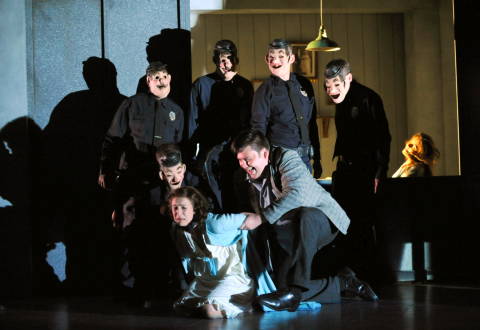
Laura Mitchell as Gilda and chorus, during Gilda's abduction in Act I. Photo © 2009 Alastair Muir
|
Edwards' performance as the Duke was also transformed when he flirtatiously (even sexily) seduced Lucas' by no means unwilling Maddalena. This performance carried through from a very creditable La donna e mobile to the quartet. Here Green and Mitchell were suitably muted and believable, still suffering the after-effects of the trauma of Act II. The quartet was a musical and dramatic tour de force. Green and Mitchell were then profoundly moving in their final duet.
Inevitably Green's Rigoletto must be seen as a work in progress, but his scenes with Mitchell's stunning Gilda showed what he could do. Mitchell showed a fully-formed staged presence allied to a beautifully gleaming spinto voice. Edwards' lovely Italianate tenor indicated a promising future, though on this showing his dramatic abilities seemed a little more variable.
Conductor Toby Purser and the Orchestra of Nevill Holt provided well-disciplined accompaniment. Purser allowed the music to flow and breathe, displaying a real feel for the ebb and flow of Verdi's lines. He gave the singers time to breathe and shape their lines. A conductor is entirely apposite in Rigoletto as it was one of the first of Verdi's operas to be performed with a modern-style pit. But the conductor must be responsive to allow Verdi's lines to flower, as Purser did here.
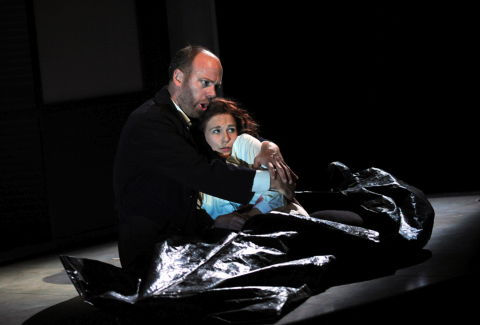
Laura Mitchell as Gilda and Adam Green as Rigoletto in the closing duet in Act III of Grange Park Opera's 'Rigoletto' at Nevill Holt. Photo © 2009 Alastair Muir
|
In a pre-performance speech Wasfi Kani, the artistic director of Grange Park Opera, thanked all involved as many of the singers, players and technical staff were either waiving their fees or taking much reduced ones. This was in order for the performance to go ahead without the support of the Arts Council funding. She described it as a classy show, which it was, classy and very good looking. Daniel Slater and Angela Davies' conception did not quite convince. But Slater had developed some strong performances from his singers. The production returns to the main Grange Park Opera festival in 2011.
Copyright © 6 October 2009
Robert Hugill,
London UK

| 
